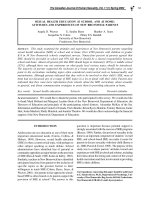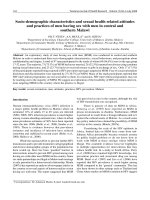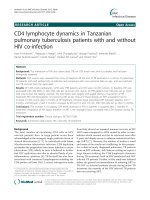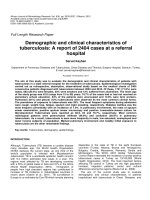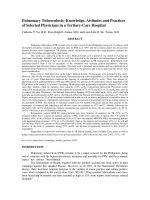Pulmonary Tuberculosis: Knowledge, Attitudes and Practices of Selected Physicians in a Tertiary-Care Hospital docx
Bạn đang xem bản rút gọn của tài liệu. Xem và tải ngay bản đầy đủ của tài liệu tại đây (40.87 KB, 10 trang )
Pulmonary Tuberculosis: Knowledge, Attitudes and Practices
of Selected Physicians in a Tertiary-Care Hospital
Catherine T. Yu, M.D., Ryan Ralph R. Zantua, M.D. and Linus John H. Sto. Tomas, M.D.
ABSTRACT
Pulmonary tuberculosis (PTB) remains to be a major concern for the Philippines, being one of countries with
the highest prevalence, incidence and mortality rates for PTB as of 1997, and the economic aspect has always been
blamed. Because more symptomatic TB patients consult the private practitioner this study therefore evaluates the
physicians' knowledge and approach to tuberculosis.
This study was conducted at the St. Luke's Medical Center over a period of one month to evaluate the
physicians' knowledge, attitudes, and practices and their approach in the diagnosis and management of pulmonary
tuberculosis and to determine if there are deviations from the guidelines in TB management. Respondents were
researcher-selected from a list of specialists of the institution and included general practitioners, internists,
pulmonologists, and infectious disease specialists. The study used a structured questionnaire and was conducted in an
assisted format. Frequencies were determined from responses to the questions and answers apart from the choices were
given consideration.
From a list of 1040 physicians in St. Luke’s Medical Center, 59 physicians were included in this study.
However, only 38 (4% of total) were interviewed. Fifty three percent of the respondents (n = 20) were male; the mean
age was 41 years. Pulmonologists comprised the majority of respondents (63.1%; n=24). Thirty four percent of
physicians (n=13) graduated between 1980 and 1989. Ninety five percent (n=36) realized the serious magnitude of the
TB problem in the country. As a means of avoiding TB infection while performing examination, majority (39%, n=16)
open their windows while no measures were taken by 19.5% (n=8) of physicians interviewed. Physicians would
suspect TB among patients who present with respiratory symptoms (87%; n=33) and 92% (n=35) among those who are
in contact with other TB patients. The National Tuberculosis Program (NTP) was rated fair by 39.5% (n=15) and had a
generally poor performance to 29% (n=11). The Directly-Observed Therapy (DOT) likewise rated fair to 23.7% (n=9).
Eighty seven percent (n=33) of the physicians interviewed would not rely on history and physical examination alone or
chest x-ray in the diagnosis of pulmonary tuberculosis. Ninety two percent of respondents (n=35) use 4-drug regimen in
the treatment of PTB. The duration of treatment usually lasts 6-8 months. Physicians educate their patients on the
importance of treatment and compliance and adverse events are explained by 97% (n=37). Monthly follow-ups are
advised by 92% (n=35) of physicians. Sputum examination are requested for those who are smear positive by 89.7%
(n=35) of doctors, as part of treatment monitoring.
Respondents suspect MDR-TB among patients who have histories of treatment for TB (97%; n=37),
treatment failure after 2 courses of standard regimens (100%; n=38), non-conversion of sputum after 5-6 months of
treatment (95%; n=36). Of these 38 respondents, 82%(n=31) have encountered MDR-TB. When encountering patients
with suspected drug resistance, 57.5% (n = 23) will add 2 drugs to the regimen and reevaluate; 15% (n = 6) will add
just one drug. Ninety five percent (n=36) of physicians fail to notify the health authority regarding pulmonary TB cases
because of the lack of awareness among 53% (n=20) and because of paperwork involved in 26% (n=10) of
respondents.
Suggestions to improve the surveillance data on TB include making forms available in the clinics as well as
proper contact personnel be made aware to our private practitioners. [Phil J Microbiol Infect Dis 2002; 31(1):1-8]
Key words: tuberculosis, knowledge, attitude, practices, DOT
INTRODUCTION
Pulmonary tuberculosis (PTB) remains to be a major concern for the Philippines, being
one of countries with the highest prevalence, incidence and mortality for PTB
1
and the economic
aspect has always been blamed.
The Department of Health, together with the medical societies has been active in their
campaign against this dreaded disease. However, as of 1997, in the Nationwide Prevalence
Survey, there had been minimal decrease in the number of smear positive and culture positive
cases when compared to the survey done from 1981-83.
2
Drug-resistant tuberculosis cases have
been increasing in number and have reached as high as 32% from reports from tertiary referral
hospitals.
3
Physicians play a key role in the diagnosis and management of patients with tuberculosis
and more PTB symptomatic patients consult the private health sector as compared to the public
health sector.
4
In an institution dominated by specialists, this study therefore evaluates the
physicians' knowledge, attitudes, practices and their approach to tuberculosis management.
General Objective
It is the general objective of the study to determine the knowledge, attitudes and practices
of specialist physicians in a tertiary–care hospital as to:
a. their idea of the magnitude of TB problem in the Philippines
b. their opinion of the National TB Program as well as the Directly-observed Therapy
(DOT).
c. the measures taken by physicians to avoid TB infection
d. diagnosis
e. treatment regimens
f. health education of patients
g. treatment monitoring of patients with pulmonary tuberculosis
h. MDR-TB cases
i. manner of gaining know-ledge of tuberculosis
Specific Objectives
1. To evaluate the physicians' approach in the diagnosis and management of pulmonary
tuberculosis.
2. To determine if there are deviations from the guidelines in TB management.
MATERIALS AND METHODS
The study was conducted in St. Luke's Medical Center among specialist physicians who
dealt with pulmonary tuberculosis patients. The survey was conducted over a period of one
month. The respondents were researcher-selected from among the list of specialist physicians
included in the directory of the Medical Arts Building and Cathedral Heights Building Complex.
An assisted interview was conducted in data collection using the structured questionnaire
developed by Hong, et al
5
and Huebner, et al
6
and modified by the present authors.
Study subjects included the general practitioners, pulmonologists, internists and
infectious disease specialists of the same institution. The respondents were asked questions on the
magnitude of the PTB problem, the Philippine TB program, directly-observed therapy (DOT),
measures taken to avoid PTB infection, diagnostic methods and treatment regimens, method of
monitoring, patient education prior to treatment initiation, MDR-TB cases and information source
on tuberculosis (Appendix I).
Frequencies were determined from responses to the questions; answers apart from the
choices as well as comments were also given consideration.
RESULTS
A total of 59 physicians were included and 64% (n=38) of these physicians were
interviewed for the study; twelve percent (n=7) were non-active consultant staff and the
remaining 24% (n=14) were not available for interview at the time of study period. Most of the
respondents were male (53%) with a mean age of 41 years. Pulmonologists likewise comprised
the majority of respondents (63%; n=24); 26.3% (n=10) were internists and 10.5% (n=4) were ID
specialists. Thirty four percent of the physicians graduated from medical school between the
years 1980 and 1989 (Table 1).
Table 1. Demographic profile of physicians included in the study
n %
Gender male 20 53.0
female 18 47.0
Age 30-39
20
52.6
40-49 9 23.7
50-59 4 10.5
60-69 1 2.6
70 and above 1 2.6
Not stated 3 7.9
n %
Year graduated from Medical School 1950-1959 2 5.3
1960-1969 0 0
1970-1979 6 15.8
1980-1989 13 34.0
1990 to present 12 31.6
Not stated 5 13.1
Specialty training Pulmonology 24 63.1
Internal Medicine 10 26.3
Infectious Diseases 4 10.5
When asked about the magnitude of the PTB problem in the Philippines, 95% (n=36)
considered it serious. Performing examinations on PTB patients pose a risk of getting infected
and 76% (n=29) are worried; the remaining 24% (n=9) are not.
Most doctors open their windows (39%; n=16) as a measure to avoid getting infection
while 24.4% (n=10) keep distance and 12.2% (n=5) wear masks. Despite the worry of getting
infected while performing examination on their patients, no measures were taken by 19.5% (n=8).
Other answers given by the respondents were to use the exhaust fan (2.4%; n=1) and the use of
the exhaust fan from the air-conditioning unit (2.4%; n=1) (Table 2).
Table 2. Measures taken by physicians to avoid PTB
Measures n %
Open windows 16 39.0
Keep distance 10 24.4
No measures taken 8 19.5
Wear masks 5 12.2
Other answer 2 4.8
*2 respondents had multiple answers
Tuberculosis presents with a myriad of symptoms, more often than not, non-specific.
However, 87% (n=33) of the physicians would suspect PTB among patients presenting with
respiratory symptoms; 92% (n=35) also say that PTB can be suspected among patients in contact
with other PTB patients. Among asymptomatic patients, 47% (n=18) may be suspicious of PTB
while another 47% (n=18) would not be. Other answers included chest x-ray findings suggestive
of PTB (3%; n=1); lymph node enlargement (3%; n=1); being Filipino (3%; n=1); symptoms of
>3 weeks (3%; n=1) may increase their suspicion of PTB.
The National Tuberculosis Program was rated fair by 39.5% (n=15) and generally poor
performance by 29% (n=11); the directly observed therapy likewise rated fair (23.7%; n=9) and
generally poor performance (26.3%; n=10) but another 26.3% (n=10) rated it good (Table 3).
Table 3. Rating of national tuberculosis program and directly observed therapy
National TB Program Directly observed Therapy
Rating n % n %
Excellent 1 2.6 2 5.3
Good 4 10.5 10 26.3
Good case management, poor treatment efficiency 7 18.4 5 13.1
Fair 15 39.5 9 23.7
Generally poor 11 29 10 26.3
Does not concern me 0 0 1 2.6
Other: No idea 1 2.6
Respondents were asked regarding their approach to the diagnosis of pulmonary PTB
(Table 4). A standard 4-drug regimen was used by most of the respondents (n=35; 92%) and the
remaining 8% (n=3) use a 3-drug regimen consisting of rifampicin, isoniazid and pyrazinamide.
The duration of treatment usually lasts 6-8 months [(n=36; 95%) (Table 5)].
Table 4. Physicians’ approach in the diagnosis of PTB
Yes No Other: depends on symptoms
n % n % n %
CXR alone 14 36.8 23 60.5 1 2.6
Sputum AFB exam 36 94.7 2 5.3
Sputum TB culture 27 71 11 29
History and PE alone 5 13 33 87
Table 5. Treatment regimen and duration for PTB
Treatment Regimen N %
3-drug 3 8.0
4-drug 35 92.0
Duration of Treatment N %
< 6 months 0 0
6-8 months 36 94.8
9-11 months 1 2.6
12-18 months 1 2.6
All respondents agree that the importance of treatment and compliance to treatment are discussed
with their patients prior to initiation of treatment. Adverse events are explained by 97% (n=37)
and monthly follow-ups are advised by 92% (n=35) of physicians. Eight percent (n=3) would
advise follow up every 2-3 months.
Sixty nine percent (n=27) do not solely rely on chest x-ray for monitoring treatment; the
physicians often mention accompanying improvement in symptomatology and well-being. One
mentioned the use of erythrocyte sedimentation rate, as part of treatment monitoring (Table 6).
Respondents suspect MDR-TB among patients who have history of treatment for TB
(97%; n=37), treatment failure after 2 courses of standard regimens (100%; n=38), non-
conversion of sputum after 5-6 months of treatment (95%; n=36). Of these 38 respondents, 82%
(n=31) have encountered MDR-TB. These patients most commonly present-ed with worsening or
no improvement of radiologic infiltrates (55%; n=17), persistent sputum AFB smear positivity
despite treatment (42%; n=13), and no improvement or worsening of symptoms [(26%; n=8)
(Table 7)].
Table 6. PTB treatment monitoring
Yes No Depends
n % n % n %
CXR alone 10 25.6 27 69.2 1 2.6
Sputum exam for those with (+) AFB 35 89.7 3 7.7
Other: ESR* 1 2.6
*1 respondent uses this in addition to CXR and sputum AFB exam
Table 7. Manifestations of MDR-TB cases encountered by respondents**
**Respondents had multiple answers
When encountering suspected drug resistance, 57.5% (n=23) will add 2 drugs to the
current anti-TB regimen they are giving and reevaluate; 17.5% (n=7) will refer to an ID specialist
for management and 7.5% (n=3) will refer to a pulmonologist. Fifteen percent; n=6) will add just
1 drug to the regimen and reevaluate. One physician did not answer this particular question, as
there had been no encounter of drug resistance (Table 8).
Table 8. Course of action of respondents to suspected drug-resistance*
Course of action n %
Add 2 drugs and re-evaluate 23 57.5
Add 1 drug and re-evaluate 6 15
Refer to Pulmonologist 3 7.5
Refer to ID specialist 5 17.5
No answer 1 2.5
* 2 respondents had multiple answers
A great deal of information can be contributed to the national surveillance data on
tuberculosis but unfortunately, 95% (n=35) of the physicians interviewed fail to notify the health
authority; as much as 53% (n=20) are not aware of the reportability of tuberculosis and 26%
(n=10) decline because of too much paperwork involved. Ten percent (n=4) do not know where
to report cases; 5% (n=2) say that no ready forms were available and 3% (n=1) was not conscious
of any surveillance being done.
In order to gain knowledge or information on tuberculosis, physicians rely on periodicals
and academic meetings attended; the Internet is also one access from which our respondents gain
information on tuberculosis.
Clinical
n
%
No improvement/worsening of symptoms 8 26
Persistent cough 6 9
Persistent fever 2 6
Weight loss 3 10
Persistent sputum production 1 3
Radiologic
No improvement/worsening of infiltrates 17 55
Persistent/increase in size of cavitary lesion 3 10
Pleural effusion 3 10
Fibrotic lesion 1 3
Others
(+) AFB smear despite treatment 13 42
Culture resistant > 2 anti-TB meds 7 23
Inadequate anti-TB treatment 7 23
Self-medication with anti-TB medication 1 3
History of previous anti-TB treatment 2 6
(+) sputum TB culture despite treatment 1 3
DISCUSSION
For the year 2001, the Section of Microbiology has received a total of 389 pulmonary
specimens, 136 (35%) of which were culture positive for Mycobacterium tuberculosis (Mtb). The
majority of these culture-positive specimens were bronchial washings (51%). But inspite of this
impressive number, during the last four months of 2001, requests for TB cultures comprise only
48% of the total number of pulmonary specimens submitted for TB work-up. Requesting for
culture for TB may not be done due to its prohibitive cost for the low-income group of patients.
Tuberculosis is transmitted through the air, however, 19.5% (n=8) of physicians do not
take necessary measures to avoid infection. Airborne transmission of tuberculosis can be limited
by techniques advised by the American Thoracic Society.
7
It is also known to be a great mimicker
of disease and presents with a variety of symptoms. Almost 90% (n=33) suspect TB among
patients with respiratory symptoms and especially since cough is its most common symptom.
7
In the presence of symptoms of prolonged duration, tuberculosis is almost always one of
the considerations. Apart from respiratory symptoms, tuberculosis may also present with
prolonged fever, weight loss and body weakness. The presence of intrathoracic or extra thoracic
lymphadenopathies, anemia and leukocytosis may also increase our suspicion of tuberculosis.
7
The National Tuberculosis Program (NTP) of the government as well as the DOT were
rated unfavorably by our respondents and only 26.3% (n=10) rated the DOT as good. Manalo et
al
8
commented that this could be due to the unfamiliarity of the program by private physicians or
they do not quite agree with the NTP of the government.
Sputum microscopy has a high rate of specificity and low rate of false negatives.
3
Ninety
five percent of the respondents follow the National TB Program by requesting for sputum
microscopy as a diagnostic tool for tuberculosis. However, the diagnosis of PTB becomes definite
when Mtb is isolated by culture. As cited in the Philippine Clinical Practice Guidelines,
3
it is ideal
to confirm all smear positive cases by culture but is not recommended as part of routine
evaluation because of its cost and areas of limited technical facilities. The problem of cost of TB
culture may be the reason why only 48% of pulmonary specimens submitted to the laboratory for
TB work-up, have TB culture requests. With the emergence of multiple drug-resist-ant
tuberculosis, isolation of the organism as well as performing drug susceptibility testing is
imperative for appropriate manage-ment.
3,7,9
A minimum of three drugs is recommended for the intensive phase treatment of a patient
newly diagnosed with PTB and for urban areas and in places with high drug-resistance, a 4-drug
regimen during the intensive phase is preferred. All our respondents follow these regimens: 4-
drug by 92% (n=32) and 3-drug by the remaining 8% (n=3).
In an article by Rivera et al,
9
the rates of MDR-TB in the Philip-pines are similar to the
weighted mean of 4.3% combined, 2.1% primary and 11.8% acquired MDR-TB reported in the
WHO/IUATLD global anti-tuberculosis drug resistance surveillance program. It is also in this
study that they found a high rate of drug resistance to isoniazid at 14.9% while that resistance to
rifampicin was 4.3%; these are two of the first-line drugs for tuberculosis.
The presence of resistance to both these potent agents complicates patient management.
Administration of at least 2 agents to which the organism is susceptible to is the main principle of
patient management with organisms resist-ant to one or more drugs.
10
This would further put
bearing on the importance of requesting TB cultures and sensitivity testing in the presence of
MDR-TB. Twenty three respondents (57.5%) would add 2 drugs to the current regimen of a
patient with suspected drug resistance and re-evaluate. Resistance to other first-line drugs has
poor outcome and in such cases, it is preferable to give at least 3 new drugs to which the
organism is susceptible.
10
It is of note that 15% (n=6) of respondents will add just one drug to the
regimen of a patient with suspected drug-resistance and this is not recommended, as addition of a
single drug to a failing regimen has been associated with the acquisition of drug resistance.
11
Treatment monitoring as well as patient education does not seem to be a significant
problem for our physicians as majority do not rely solely on chest x-ray (69.2%; n=27) and
requesting for sputum exam for smear-positive cases are followed by 89.7% (n=35).
Knowledge or information on tuberculosis is gained mainly through periodicals and
attending academic meetings. The internet is also a rich source of updated information on this
subject. Much effort is needed on the part of our doctors in notifying our health authorities
regarding TB patients. The unavailability of ready forms in the offices of our private
practitioners, the lack of information on the health authority to contact and not just the paperwork
that it entails may have contributed to a certain degree to the poor forwarding of information.
Definitely, the private sector has a role to share in the control of tuberculosis.
CONCLUSIONS
Selected physicians in a tertiary care hospital as St. Luke’s realize the magnitude of TB
problem in the country. However, the majority does not favorably rate the National TB Program
and DOT. The lack of awareness that TB is reportable and the paperwork it entails limits the data
on its surveillance. Report forms as well as the proper contact personnel should be made available
in the clinics of our private practitioners.
It has been found out that majority of our respondents follow the recommended guidelines in
the diagnosis, management and treatment monitoring for tuberculosis. Most would not rely solely
on chest x-ray or history and physical examination for its diagnosis. The use of sputum
microscopy and TB culture are still requested for proper diagnosis, however, because of the high
cost of TB cultures, this is not requested routinely.
A 4-drug regimen is given by 92% and 3-drug regimen given by 8% of respondents at the
initiation of treatment and the total duration of treating a PTB patient usually lasts 6-8 months.
Eighty two percent (n=31) of the total respondents have encountered MDR-TB and in their
approach to managing drug-resistant TB cases, although 2 drugs are added by 57.5% of
physicians, it may be of concern that 15% add just one drug. This may contribute to failure of TB
treatment and pose problems in the future.
Acknowledgement
The authors would like to thank the kind hearts of Drs. Francisco V. Narciso and Evelina V. Lagamayo for
allowing us to gather in-house data on tuberculosis despite the very limited space in the Microbiology Section.
REFERENCES
1. World Health Organization. Tuberculosis control in the Western Pacific Region 1999: Review of TB epidemiology.
2. Tupasi TE, Radhakrishna S, Rivera AB, Pascual MLG, et al. The 1997 Nationwide Tuberculosis Prevalence Survey in the
Philippines. Phil J Microbiol Infect Dis 2000; 29(2): 104-111.
3. Task Force on Tuberculosis, Philippine Practice Guidelines Group in Infectious Diseases. Pulmonary Tuberculosis: Clinical
Practice Guidelines. PPGG-ID Philippin e Society for Microbiology and Infectious Diseases and Philippine College of Chest
Physicians.
4. Quelapio MID, Mira NRC, Abeleda MR, Rivera AB, et al. Directly observed therapy-short course (DOTS) at the Makati
Medical Center. Phil J Microbiol Infect Dis 2000; 29(2): 80-86.
5. Rivera AB, Tupasi TE, Balagtas ED, et al. Multi-drug resistant tuberculosis in the Philippines: implications for therapy. Phil J
Microbiol Infect Dis 2000; 29(2): 68-72.
6. Hong YP, Kwon SJ, Chang SC, Kang MK, Lee EP, Moon HD, Lew WJ. Survey of knowledge, attitudes and practices for
tuberculosis among general practitioners. Tuberc Lung Dis 1995; 76: 431-435.
7. Huebner RE, Moeti TL, Binkin NJ, Rumisha DW. Survey of physician use of radiography and sputum smear microscopy for
tuberculosis diagnosis and follow-up in Botswana. Int J Tuberc Lung Dis 1997; 1(4): 333-338. American Thoracic Society and
the Center for Disease Control and Prevention. Diagnostic standards and classification of tuberculosis in adults and children. Am
J Respir Crit Care Med 2000; 161: 1376-1395.
8. Manalo MFC, Pineda AV, Montoya JC. Knowledge, attitudes and practices for tuberculosis among Filipino Family
Physicians: a comparative analysis by practice setting and location. Phil J Microbiol Infect Dis 1998; 27(1): 6-12.
10. American Thoracic Society and the Center for Disease Control and Prevention. Treatment of tuberculosis and tuberculosis
infection in adults and children. Am J Respir Crit Care Med 1994; 149: 1359-74.
11. Mahmoudi A, Iseman MD. Pitfalls in the care of patients with tuberculosis: common errors and their association with the
acquisition of drug resistance. JAMA 1993; 270: 65-68.
Appendix I: Questionnaire Form
Pulmonary Tuberculosis (PTB): Knowledge, Attitudes and Practices of Selected Physicians in a Tertiary Care
Hospital
Doctor’s Initials: ______ Age: ____ Sex: male female
Specialty: General Practitioner Internal Medicine
Pulmonary Infectious Disease
Year graduated from Medical School: __________
Please check one:
1. How do you see the magnitude of TB problem in the Philippines?
( ) serious ( ) not so serious
( ) not a problem ( ) don’t know
2. Are you concerned about getting TB infection while performing examination on your patient?
( ) Worried ( ) not worried
3. What measures do you take to avoid infection?
( ) keep distance ( ) open windows ( ) wear mask
( ) no measures taken
4. When do you suspect Tb in a patient?
4.1 Do you suspect TB in patients with respiratory symptoms? ( ) yes ( ) no
4.2 Do you suspect TB in patients with contact with TB patients? ( ) yes ( ) no
4.3 In any case, because they may be asymptomatic? ( ) yes ( ) no
other reason/s: ________________________________
5. How would you rate the National TB program?
( ) excellent ( ) good ( ) fair
( ) good case management ( ) generally poor ( ) does not
but poor treatment efficiency performance concern me
6. How would you rate the Directly-Observed Therapy program?
( ) excellent ( ) good ( ) fair
( ) good case management ( ) generally poor ( ) does not
but poor treatment efficiency performance concern me
Diagnosis of PTB Patients
1. How do you diagnose TB?
1.1 Do you diagnoseTB using Chest x-ray alone? ( ) yes ( ) no
1.2 Do you request for sputum exam for the diagnosis of TB? ( ) yes ( ) no
1.3 Do you request for sputum TB culture in the diagnosis of TB? ( ) yes ( ) no
1.4 Do you diagnose TB based on history and physical exam alone? ( ) yes ( ) no
Treatment regime n and duration of treatment (in months):
1. In the initiation of treatment for TB, what regimen do you start the patient with and for how long? (Please
encircle)
A. HRZ with or w/o other drugs < 6 6-8 9-11 12-18
B. HR w/ or w/o other, no PZA < 6 6-8 9-11 12-18
C. H w/ other, no Rifampicin < 6 6-8 9-11 12-18
D. 2,3,4 drug, no Isoniazid < 6 6-8 9-11 12-18
E. RP with other < 6 6-8 9-11 12-18
F. monotherapy < 6 6-8 9-11 12-18
H: Isoniazid R: Rifampicin PZA: Pyrazinamide P: PAS
2. Do you advise patient on the importance of treatment and patient compliance?
( ) yes ( ) no
3. Do you explain adverse events of anti -TB medicines to patient prior to initiating treatment?
( ) yes ( ) no
4. Do you advise monthly follow-up to monitor patients?
( ) yes ( ) no
Treatment Monitoring
1. Do you monitor treatment by chest x-ray alone?
( ) yes ( ) no
2. Do you monitor treatment by requesting for sputum exam for those with (+) AFB smear?
( ) yes ( ) no
MDR-TB CASES:
1. When would you suspect MDR-TB in a patient?
1.1 Would you suspect MDR-TB in a patient who has history of treatment for TB?
( ) yes ( ) no
1.2 Would you suspect MDR-TB in a patient who has treatment failure after 2 courses of standard regimens?
( ) yes ( ) no
1.3 Would you suspect MDR-TB in a patient who has cavitary and bilateral lesions?
( ) yes ( ) no
1.4 Would you suspect MDR-TB in a patient who has non-conversion of sputum AFB after 5-6 months of treatment?
( ) yes ( ) no
2 Have you encountered an MDR-TB case?
( ) yes ( ) no
3 What were their manifestations?
Clinical: __________________________________________________________
__________________________________________________________
Radiologic: _______________________________________________________
_______________________________________________________
Others: _____________________________________________________________
4 What will you do if you encountered a patient with suspected drug-resistance?
( ) Add one drug to current regimen and reevaluate
( ) Add two drugs to current regimen and reevaluate
( ) Refer to an Infectious disease Specialist for consult
( ) Refer to a Pulmonologist for consult
Case Notification
1. Do you notify the Health authority when you have a TB patient?
( ) yes ( ) no
If you answered no, why?
( ) not aware that Tb is reportable ( ) too much paperwork
2. What are the ways of gaining information/knowledge on TB? (you may check one
or more)
( ) textbook ( ) periodicals ( ) academic meetings ( ) I do not seek any info on TB

